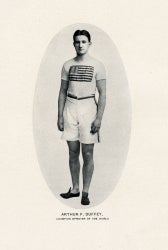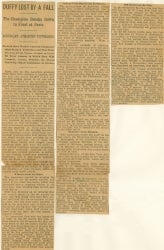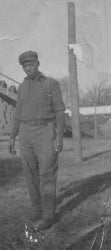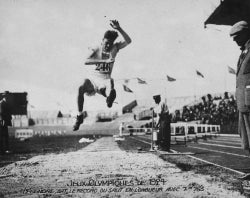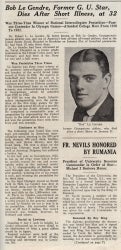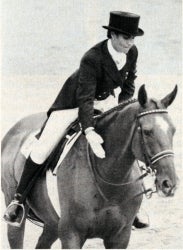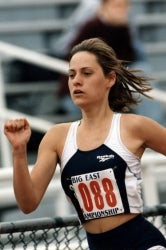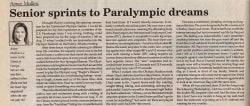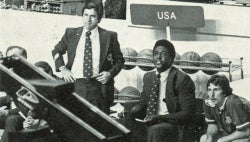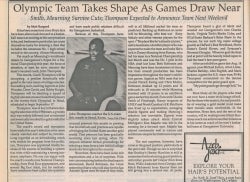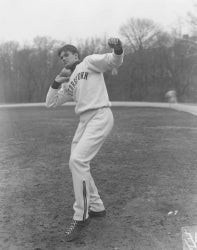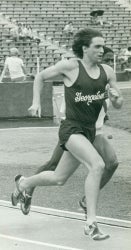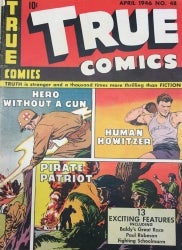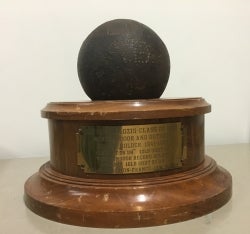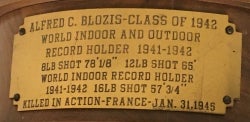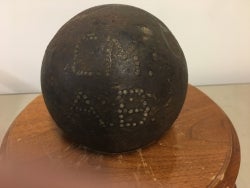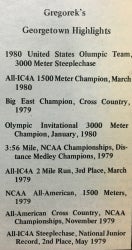Georgetown can be proud of its long summer Olympic tradition. At least 40 Georgetown athletes have competed in previous summer Olympic and Paralympic Games, beginning with the 1900 Paris Olympics. Several Hoyas have competed in two Olympiads: Robert LeGendre, track and field, 1920 and 1924; James Connolly, track and field, 1920 and 1924; and Patrick Ewing, basketball, 1984 and 1992.
Additionally, a number of Hoyas are competing at the 2021 Tokyo games: Rachel Schneider (NHS’2013, G’2015) and Amos Bartelsmeyer (SFS’2018, G’2019) in track and field for the U.S. and Germany respectively; Charlie Buckingham (C’2011) as a member of the U.S. sailing team; and Daisy Cleverly (G’2025) as a member of the New Zealand women’s soccer team.
Georgetown athletes have or are competing in Olympic track and field, cycling, sailing, rowing, basketball, equestrian, kayaking, swimming and soccer events. And their participation and achievement is complemented by other Hoyas who have contributed to the Games as coaches, administrators, tv analysts, and staff. This exhibition highlights just a few of these Hoya Olympians.
Arthur Francis Duffey* (L’1903). Competed in sprint events at the 1900 Paris Olympics. Pictured in the Hodge Podge (GU yearbook), 1904
Born in Boston, Duffey was one of the greatest athletes to attend Georgetown. He held multiple national and world sprint records and became known throughout the country as the world’s fastest man. At the time of the Paris Games, he held the world record for the 120 meters at 11 4/5 seconds. By far the favorite to win the 100 meters, he pulled a tendon and fell while in the lead during the Olympic final. He did not finish and was subsequently unable to compete in the 60 meter dash which he had also been expected to win. After retiring as a competitive runner, he joined the sports staff of The Boston Post.
A video of Duffey competing at a track meet in Birmingham, England, on July 12, 1902 can be viewed on YouTube; he appears at the 6 minute mark. (Thanks to Bennie Smith, C’1986, for alerting the GU Archives to the existence of this fascinating recording.)
*Comparison of the caption on the 1904 yearbook photograph and the 1900 newspaper clipping displayed below will reveal two different spellings of this name. Duffy is the spelling favored in GU publications at the time he was a student.
“Duffy Lost by a Fall.” Results of the first day of competition in Paris, Saturday, July 14, 1900. Clipping from an unidentified newspaper
Duffey describes his collapse in the 100 meters final: I do not know why my leg gave way. I felt a peculiar twitching after going twenty yards. I then seemed to lose control of it, and, suddenly, it gave out, throwing me on my face. But that is one of the fortunes of sport, and I cannot complain. I am glad the event went to an American. The race was won by Horace F. Jarvis of Princeton.
All track events at Paris were held over the weekend of July 14-15, 1900. The finals of the 100 meters had originally been scheduled for July 15. However, many of the American athletes objected to racing on a Sunday. As a concession, the finals were moved back a day. This change meant that the sprinters had to run three races (a heat, the semifinal and the finals) in one day, a circumstance which may have contributed to Duffey’s injury.
Championnats Internationaux, 1900. Official Program
This program was brought back from Paris by Arthur Duffey. Interestingly, it does not actually contain the word “Olympic.” The 1900 Games were greatly overshadowed by the World Exhibition, also held in Paris that summer. The French Government wrested control of the Games from Baron Pierre de Coubertin, founder of the modern Olympics and president of the International Olympic Committee, but took few steps to market them and put little effort into planning or organization.
Theodore “Thee” Woodward. Trainer to GU athletes at the 1900 Paris Games. Pictured in 1914
Mr. Woodward came to campus around 1895 and is probably the first African American to have been involved in Georgetown athletics. He accompanied Arthur Duffey and his two teammates to Paris.
A number of Hoyas have contributed to Olympic games in non-competitive, non-coaching roles. In addition to Trainer Theodore Woodward, these include:
- Edward Rosenblum (L’1917) who was instrumental in persuading Congress to pass legislation regulating boxing in the District of Columbia in the early 1930s and attended six Olympics as an official of the U.S. Olympic Committee
- Mary Korfonta (N’1943) who was appointed nurse for the U.S. Olympic team at 1956 Melbourne Games
- George Eastment (L’1927) who was Chair of the U.S. Men’s Olympic Track and Field Committee from 1961 to 1964;
- Park Jong Sei who did post-doctoral research at GU and was Director of the Doping Control Center at the 1988 Seoul Olympics where he received worldwide attention for his role in detecting the steroid use of Canadian sprinter Ben Johnson;
- Lorry Michel who joined the athletic training staff at Georgetown in 1977 and worked with the U.S. Men’s basketball team at the 1988 Seoul Games and with the U.S. kayaking team at the following games in Barcelona;
- Michael Vespoli (B’1968) who competed in the Four-Oared-Shell-With-Coxswain at the 1972 Munich Games and served as NBC’s expert commentator for the rowing events at the 1992 Barcelona Games;
- Tyrone Lockhart (B’1987) who acted as Administrator of Value-In-Kind Programs at the 1996 Atlanta Games;
- Monica McNutt (C’2011) who is serving as an NBC analyst on Olympic basketball at the 2021 Tokyo Games;
- Michelle Konkoly (C’2014) who is providing color commentary for NBC on the swimming competition at the 2021 Paralympic Games.
Robert L. LeGendre (C’1922, D'1927). Competed in the pentathlon and decathlon at the 1920 Antwerp Games and the pentathlon at the 1924 Paris Games. Pictured setting a broad jump world record in Paris
One of the greatest all-round athletes to represent Georgetown, LeGendre was the mainstay of the University’s track team during his undergraduate years. In April 1920, he broke his leg but still qualified for the pentathlon and decathlon at the U.S. Olympic trials that year. In Antwerp, he finished tied for third with Hugo Jalmari Lahtinen of Finland in the pentathlon, even though his leg was not fully healed. Scoring according to percentage tables gave Lahtinen third place and LeGendre fourth.
Despite doing little training after graduation from Georgetown in 1922 while he considered an acting career, LeGendre qualified for the 1924 Olympics. He placed third in the Pentathlon, setting a new world record for the broad jump of 25 feet 6 inches in the process. Ironically, he had failed to qualify in that individual event at the U.S. Olympic trials.
Obituary for Robert LeGendre from The Hoya, January 28, 1931
After graduating from Georgetown’s Dental School in 1927, LeGendre became a Lieutenant in the Naval Dental Corps. He died of bronchial pneumonia in 1931, aged only thirty-three.
Marian Cunningham (F’1975). Competed in equestrian events at the 1984 Los Angeles Olympics. Pictured on her horse El Dorado in the Georgetown Magazine, November-December 1984
Competing for Peru, Cunningham was her country’s first Olympic equestrian competitor. She was also the first female Hoya to compete in the Olympics, the first Hoya to compete in an equestrian event at the Olympic-level, and the first Hoya to compete for the national team of another country since hurdler Erik Kjellstrom (C’1930) represented Sweden in 1928. She did not medal but finished ahead of every other Latin American rider.
Aimee Erin Mullins (F’1998). Competed in Paralympic long jump and sprints at the 1996 Atlanta Olympics. Pictured in the Georgetown Magazine, Winter 1997
The first Georgetown athlete to compete in the Paralympic Games*, Aimee Mullins broke world records in the 100 meters, 200 meters, and long jump at Atlanta. A double-below-the-knee amputee, she competed for Georgetown against non-disabled athletes and received the BIG EAST Academic All-Star Team honors for the 1995-1996 season. She was named Disabled Athlete of the Year by U.S.A Track & Field in 1997. After graduation from Georgetown, she forged a successful career as an actress and public speaker.
Michelle Konkoly (C'2014) competed in swimming events at the 2016 Rio Paralympic Games, winning four medals (two gold, one silver and one bronze). She is providing color commentary for NBC on the swimming competition at the 2021 Paralympic Games.
*The Paralympics are the Olympic-equivalent games for athletes with physical disabilities. They are the world’s second largest sporting event after the Olympics.
John Thompson, Jr. Assistant U.S. Basketball Coach at the 1976 Montreal Olympics and Head U.S. Basketball Coach at the 1988 Seoul Olympics. Pictured watching the 1976 basketball finals with U.S. Olympic Coach Dean Smith in Georgetown Today, Sept. 1976
In the 1976 Olympic basketball finals, the U.S. Men’s basketball team faced a Yugoslavian team which had defeated Russia in the semi-finals. The U.S. team easily won the gold medal by a score of 95 to74 points. Coach Thompson commented that participating in the Olympics was the most rewarding experience of his career to date: Winning a gold medal is definitely the highlight of my career. If I had to do it over again I would. It was good for both me and the University to be part of the Olympics. I was proud to represent the School.
“Olympic Team Takes Shape As Games Draw Near.” Georgetown Voice, August 26, 1988
Coach Thompson was appointed as a selector for the U.S. Olympic Basketball team in 1984 and as U.S. Olympic Head Basketball Coach in 1988. He was assisted in preparations for the 1988 games by Georgetown Assistant Coaches Craig Esherick and Mike Reilly and by Academic Coordinator Mary Fenlon. Head Trainer for the Georgetown Men’s Basketball team Lorry Michel also worked with the Olympic team. Alonzo Mourning, then the no. 1 high school recruit in the country, participated in the Olympic trials.
The U.S. team defeated Spain (97-53), Brazil (102-35), China (108-57), Egypt (102-35) and Peru (94-57) before losing to the U.S.S.R. (82-76) in the semi finals. The team clinched the bronze medal by beating Australia (78-49).
A number of other Hoyas have coached U.S. Olympic teams including George Eastman (L’1927) who was Assistant Coach for the U.S. track team in the 1960 Rome Olympics and Tony Johnson who was Assistant Rowing Coach at the 1972 Munich Games. Additionally, Elmer H. Ripley, Georgetown’s Men's Basketball Coach from 1927 to 1929, 1938 to 1943 and 1946 to 1949, served as the Israeli Olympic Basketball Coach in 1956 and the Canadian Olympic Basketball Coach in 1960.
Alfred C. “Al” Blozis (C’1942), pictured in 1940, and John Gregorek (C’1982), pictured ca. 1980
This exhibit closes by acknowledging Georgetown athletes who qualified for the Olympics but were prevented from competing in them, among them Alfred C. “Al” Blozis who would have been the clear favorite to win the shot put at the 1940 Olympics, had they not been cancelled due to World War II, and John Gregorek who finished third in the 3000 Meter steeplechase at the 1980 U.S. Olympic trials, becoming the first Georgetown track and field athlete since Charles Capozzoli in 1952 to qualify for the Olympic squad. However, in April 1980, the U.S. Olympic Committee voted by a 2-1 margin to boycott the Moscow Games in protest at the Soviet invasion of Afghanistan and so Gregorek missed his opportunity to compete. Also prevented from competing was John J. Gallagher (xL’1914) who qualified for the U.S. Olympic marathon team in 1908 but was not permitted to go to the Games because he was only 17 years old. He did, however, compete in the 1912 Stockholm games where he finished 7th in the marathon finals.
Cover of True Comics, April 1946. No. 48
At 6 feet 6 ½ inches and 248 pounds, Al Blozis’ size and strength earned him such nicknames as “Big Al” and the “Hoya Hercules.” Participating in fifty-five college track meets, he never lost a shot event and he held five world shot records concurrently, for the16 lb indoor shot, the 12lb indoor and outdoor shot, and the 8lb indoor and outdoor shot. He also played right tackle on the Georgetown football team that went undefeated for 23 games and made an appearance in the 1941 Orange Bowl. Chosen as a member of the National Collegiate All-American Football team in 1941, he played tackle for the New York Giants after graduation.
When war broke out, each of the three branches of service initially refused to induct him on the grounds that he was too tall. After height requirements were changed, he enlisted in the Army in late 1943. He was killed in action in January 1945, during the Battle of the Bulge.
Blozis’ fame was such that, even after his death, he was featured in a comic strip as the “human howitzer.”
"Gregorek's Georgetown Highlights." Georgetown Voice, September 9, 1980
John Gregorek began running as a high school sophomore and over time developed enough versatility to successfully compete in every event from 800 to 10,000 meters. He was Big East Cross Country Champion in 1979 and won the IC4A 1500 Meter Championship in 1980. Ranked among the top 25 Americans in three different events, the 1500 meters, 5000 meters and the steeplechase, Sport Magazine named him “the top track and field prospect of the 1980's”.
After the 1980 Olympic boycott by the U.S., Gregorek continued to train and compete and won the gold in the steeplechase at the 1981 World University Games held in Bucharest, Roumania, breaking his own school and World University Games record with a time of 8:21:26. By the time he graduated in 1982, he was an eight-time All American. A second chance to compete in the Olympics came when he qualified for the 1984 U.S. team. Unfortunately, several weeks before the Games, he contracted a severe case of bronchitis. He had to curtail training, arrived in L.A. in a weakened state, and was eliminated in the semi-final round. He competed in his third set of Olympic trials in 1992, finishing third in the 5000 meter final but not in an Olympic qualifying time.
Curated by Lynn Conway, University Archivist

